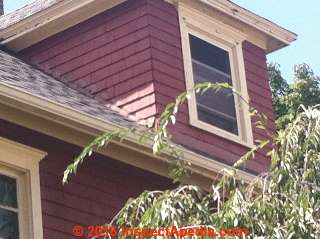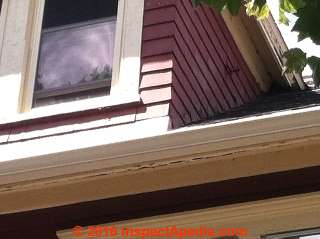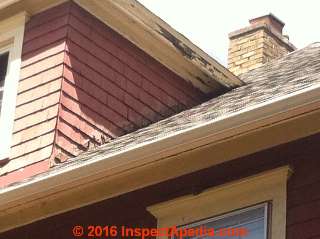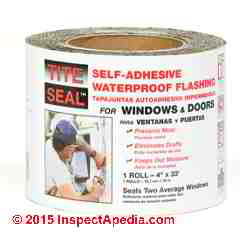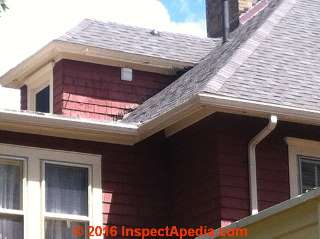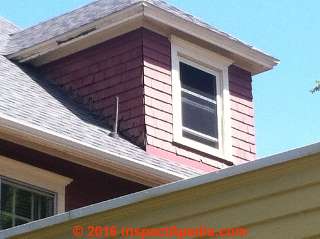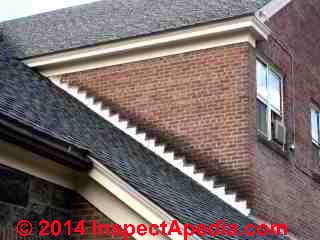 Roof Dormer Flashing
Roof Dormer Flashing
Dormer Sidewall Flashing @ Roof-Wall Intersection
- POST a QUESTION or COMMENT about how to install wall, foundation, & roof-wall flashing on buildings
Building roof dormer side-wall flashing materials, choices, installation details & specifications:
This article describes mistakes at roof dormer sidewall flashing and roof dormer sidewall coverings that invite leaks, rot, and insect damage on buildings.
We discuss the importance of keeping wood siding clear of the roof surface, the need for flashing at the dormer side to roof intersection, and the need for counter-flashing at step flashing along the same roof-wall intersection.
This article series provides details of building flashing details at roofs, walls, dormers, foundation tops, building walls, exterior trim, wall corners, and roof-wall intersection flashing to prevent leaks & water damage.
We describe the different flashing materials that can be used, how and where flashing should be installed at various building wall intersections and corners, at the intersection of a roof and building wall, at other locations, and how to seal these locations against leaks or insect damage.
InspectAPedia tolerates no conflicts of interest. We have no relationship with advertisers, products, or services discussed at this website.
Roof Dormer Flashing Details, Mistakes & SNAFUS
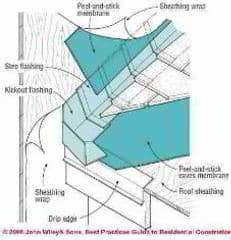 Proper installation of flashing and counter-flashing at the intersection of a vertical wall with a roof surface is required to avoid roof leaks.
Proper installation of flashing and counter-flashing at the intersection of a vertical wall with a roof surface is required to avoid roof leaks.
Our page-top photograph illustrates a successful installation of flashing and counter flashing along intersection of a roof surface with the side of a brick-constructed dormer. Even though more than a decade of rain splash-up along the dormer sidewall had stained the wall black, the roof was not leaking. Counter-flashing let into the brick mortar joints sealed the top of roof-wall flashing that you can't see.
The sketch shown here, courtesy of Steve Bliss and J Wiley & Sons, is discussed in detail
where we provide more details about the right way to install flashing at the roof-to-wall intersection.
There you will see that step flashing where each shingle course abuts a building sidewall is used to direct water out onto the surface of shingle courses below, and that counter-flashing is required to cover the upper edge of the step flashing along hte side-wall to keep water from running behind the flashing and into the building.
We also keep wood siding an inch or two "proud of" (above) the roof surface since wood edges in contact with the roof surface are going to rot.
Reader Question: Improper, Missing, Leaky Flashing Details at Dormer Side to Roof Surface Led to Rot Damage
2016/08/07 Nancy said: home inspector mentioned nothing about missing flashing, visible rot, damage at the roof dormers
I recently bought a 1925 Foursquare in upstate NY. Hip roof, four dormers; sided with cedar shakes. Sellers had tear-off roof put on in 2011 but flashing job was clearly sloppy, especially around the dormers, and I now have roof leaks in two separate locations.
[Click to enlarge any image]
Original roofer will not respond to my calls. Cedar shakes at bottom of some dormer sidewalls are rotted so I'm assuming these and flashing were not replaced during job; in other places the step flashing was applied OVER the shakes.
I've got 2 estimates of $1600-2400 to fix. One guy is proposing cutting back rotted shakes and inserting a 1x6 board to save the labor costs of replacing the shakes, but will that work? I have photographs if that helps.
I also have a problem with water running from behind the gutters (installed by same contractor who did roof). Continued to happen after gutters were cleaned. There is a drip edge but maybe it was installed wrong? Any suggestions on what to look for?
Any help would be appreciated; I searched the site but could find nothing for this specific situation. - also by private email 2016/08/08
This question and discussion were posted originally at FLASHING on BUILDINGS
Reply: Roof Dormer Flashing Details
Above: looks as if wood shingles were rotted or were cut back; flashing might extend under these shingles; if not and if counter flashing is absent, roof leaks are likely - Ed.
Nancy
Even from just your description it sounds as if the roof flashing was improperly installed - which may explain why the original contractor doesn't want to accept the can of worms involved in fixing the job. Nor do you want more work done by someone who doesn't know how to do the job properly.
Above: wood shingle sided roof dormer with a hint of damage to wood shingles too-close to the roof surface and perhaps without proper flashing. A closer inspection of this area is needed as roof and siding repairs are likely to involve a significant expense. - Ed.
No one can accurately diagnose the trouble nor prescribe the proper repair by e-text.
You're welcome to use the page bottom CONTACT link to send us some photos for comment, but what you want is an onsite expert, someone with no conflicting interests, who can inspect, diagnose, prescribe the required repair, and who can explain it to you in a way that you have confidence in the result.
The photos you sent (shown here) are a bit blurry and nobody should pretend they can inspect a building by email, but it is rather easy to see what looks like (to be confirmed by a ladder at roof edge, inspection by binoculars, or an on-roof inspection, possibly also by looking out of dormer windows. ):
Above: rotted wood shingle siding on a roof dormer where shingles were brought into contact with the roof surface; look for leaks and hidden damage to the dormer and roof structure in this area; Also notice the peeling and perhaps rotted fascia and trim along the roof dormer soffit.
1. improperly installed, incomplete dormer side flashing: no counter flashing has been installed
2. rotted damaged wood shingles along vertical sidewalls abutting lower roof surfaces
3. Peeling paint, possibly rot damage at the dormer roof fascias, worst where the fascia boards contact the main roof
4. Possibly a plumbing vent that's too close to an operable window, small diameter vent piping that may indicate older, possibly antiquated drain waste vent piping or galvanized iron piping (prone to rust, clogs, costly replacement)
But then I'm just guessing from some blurry photos.
Above: peel-and-stick flashing tape can help seal problem areas around windows, doors, and other difficult-to-seal areas at building roof or wall penetrations.
The more you read (in this article series for example) about proper and improper roof flashing and counbter-flashing
and also about PEEL & STICK FLASHING MEMBRANES - see the image just above - that can help stop leaks in problem areas) the more you might be able to make sense of what you're being told.
Above: rotted wood shingle siding on a roof dormer; exposed flashing, suspected leaks into the dormer wall/roof intersection. This roof might be easily accessible for inspection through the dormer window.
Nancy said: home inspector said "going on roof is not permitted by insurance companies"
... thanks for your response ... . I just emailed you several photos of my dormers; even if you can't add any additional feedback, the pictures may be useful for your collection! One side note that may be of help to other home buyers:
Most home inspectors (at least in this area) are not insured to go on the roof, and if areas like my 3rd story dormers are not easily visible from the ground -- most of my images had to be taken from neighbor's yards -- they may be missed.
Neither the seller's inspection report nor mine mentioned anything about the dormer flashing; and if it's not visible, my understanding is that the inspector is not responsible for pointing it out. This info may be covered elsewhere on the site but thought I'd mention here.
Above: damaged wood shingle siding on a roof dormer; also note the location of that small-diameter plumbing vent, possibly too close to an operable windows. This roof surface also looks readily accessible through the dormer window.
Mod replied: baloney
Nancy,
OPINION: "not insured to go on the roof" is baloney in my opinion; serious professional home inspectors know perfectly well that there are important and possibly costly roof and roof-flashing conditions that cannot be inspected or even seen from the ground, binoculars, or by ladder at the roof edge.
While no homeinspector is ever required nor expected to do anything that she or he feels is unsafe or that will in the inspectors's judgment damage the building, the "we don't ever go on the roof" limitation is also used by some people as an excuse to speed up and simplify the home inspection process, limit the inspection's scope, and make the real estate and selling parties happier than ever since less information will be disclosed to the home buyer.
To be fair, I would not go on to a roof if I felt I could not safely do so or if I felt that accessing it by walking on it would cause damage. And many flashing details are hidden by the roof covering - shingles for example.
Luckily there are also often subtle clues that can be seen from outside as well as leak stains or similar clues seen from in an unfinished attic space that can be most helpful. An inspector who doesn't bother to tell you what these observations mean is not doing the best job.
In sum, a home inspector is not responsible for pointing out hidden conditions, nor is the inspector required to include inspection of components that the inspector has a reason to exclude.
However a home inspector is obligated to do more than point out those exclusions to you.
A home inspector must also tell you what his or her observations as well as inspection limitations mean to you as a home buyer, owner, or occupant.
The home inspector, based on education, judgment, and experience, can and should also to give you a clue about the significance of excluded areas or topics, an interpretaion of what can be seen, and advice about the need for and how you to obtain more expert inspections and advice.
That is, usually there is at least some evidence that the inspector can see that would or should raise or lower the urgency of further investigation. Telling you that would be working for your interest.
At ARTICLE INDEX to BUILDING & HOME INSPECTION you will find a complete list of home inspection standards and ethical codes.
Reader follow-up: the roofer suggested tar patching as a temporary fix at the roof dormer
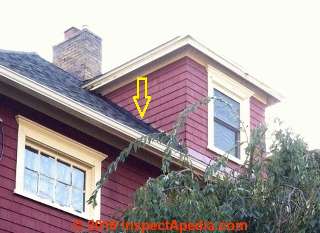 The chair of the city Historical Preservation Commission (not sure if I mentioned that my house is a designated historic home, so any changes to the exterior need to be approved) referred me to a contractor who also owns a designated homes in town.
The chair of the city Historical Preservation Commission (not sure if I mentioned that my house is a designated historic home, so any changes to the exterior need to be approved) referred me to a contractor who also owns a designated homes in town.
He felt that the fix suggested by the other contractor of cutting off the bottom row of cedar shakes parallel with the main roof line and adding a 1x6 board--although it would work -- would need HPC approval.
Since a proposal is required 3 weeks prior HPC monthly meetings, I didn't want to wait that long to address this because it was an active leak, so the contractor suggested a cheap, temporary fix: spreading a thick layer of tar over disintegrated shakes.
He wouldn't give me a guarantee on how many years it would last, but it will hopefully buy me time until I can replace the cedar shakes the right way.
Pic attached--not ideal but it doesn't look as bad as I'd feared it would.
He fixed the issue with rain flowing
behind the gutters by adding a strip of metal behind the drip edge to direct rain into the gutter. I noticed the difference with the next rain--no more curtains of rain outside the windows!
Thanks again for your help and the valuable service inspectapedia provides! - N. C. 2016/09/20
Moderator reply:
Spreading tar (probably not tar but roof flashing cement, a thick bituminous paste) will work as a short term fix, but won't be durable, especially against old, rotted, deteriorated or wet wood shingles on a dormer side. In addition it's ugly and it's deferring the proper repair that ultimately will need to cut out and replace the tarred materials.
"cutting off the bottom row of cedar shakes parallel with the main roof line and adding a 1x6 board--although it would work -- "
May also not be a good solution and may not "work" to keep water out of the dormer side wall nor roof below: certainly it risks leakage unless zee flashing is installed up under the remaining siding and over the top of the let-in 1x6 board, so we're gaining little in that repair approach.
A better repair approach for the leaky dormer sides will, as we've discussed involve the following:
Remove wood shingles with care, up one or two courses sufficient to install proper sidewall flashing and counter flashing; reinstall new wood shingles, keeping the bottom of the shingle 1-2" above the roof surface below.
That's a bit more labor to work carefully as adding shingles at the bottom of a wall requires some experience to know how to remove the old and add the new without wrecking more of the wall covering. On a historic home it'd be appropriate.
At FIBER CEMENT SHINGLE REPAIRS I describe how we cut nails and remove shingle-type siding from the bottom of a wall.
It sounds a bit hard-nosed, but IMO someone who slaps on another layer of roofing without paying attention any attention at all to proper flashings is not a roofer they're an amateur - or worse.
The roofer told me that flashing was extra - that sounded as if roof flashing wasn't necessary
Years ago a smart friend of mine, H.L., a local pediatrician in Poughkeepsie, was not, however, very house smart. And H was a bit of a penny pincher. In obtaining bids on re-oofing work on his older home he opted for the cheapest roofer's bid. That's something that might also be expected of someone discovering, when selling their home, that a repair is needed to market the property. Caveat emptor.
Later H. gave me a call, sounding quite upset.
"My new roof leaked like mad at the very first rainfall. Please come take a look."
I saw that the roofer had ignored any flashing along side of dormers and chimneys on H.'s "new roof". H's roofing job was "guaranteed until the roofer's truck passed the end of H.'s driveway". In other words not. When I pointed out to H. that there was no roof flashing and that that was why the roof leaked he explained:
"The roofer told me that on this job the flashing would be extra. To me it sounded as if "extra" meant not needed. So I told him 'Don't gouge me with extra costs, just do the roof like we discussed.'"
My opinion was that a real roofer would have included all necessary details in the roofing job and would have charged for them. "Roofing" on a home includes more than nailing on shingles. The job of the roof is to keep water out of the structure. Just sayin'.
This article series includes excerpts or adaptations from Best Practices Guide to Residential Construction (Steve Bliss, J Wiley & Sons) , by Steven Bliss, courtesy of Wiley & Sons.
- Steve Bliss's Building Advisor at buildingadvisor.com helps homeowners & contractors plan & complete successful building & remodeling projects: buying land, site work, building design, cost estimating, materials & components, & project management through complete construction. Email: info@buildingadvisor.com
Steven Bliss served as editorial director and co-publisher of The Journal of Light Construction for 16 years and previously as building technology editor for Progressive Builder and Solar Age magazines. He worked in the building trades as a carpenter and design/build contractor for more than ten years and holds a masters degree from the Harvard Graduate School of Education. Excerpts from his recent book, Best Practices Guide to Residential Construction, Wiley (November 18, 2005) ISBN-10: 0471648361, ISBN-13: 978-0471648369, appear throughout this website, with permission and courtesy of Wiley & Sons. Best Practices Guide is available from the publisher, J. Wiley & Sons, and also at Amazon.com
Comment:
(Sept 14, 2011) robert helton said:
all flashing against brick the mortor joints should be saw out first an the flashing she be turn in the wall at least an inch an then a plug she be installed in the joint each flag should be soldiered together an then tuck pointed an the all corners she be soldiered not caulk an any exposed nails she be soldiered
...
Continue reading at FLASHING WALL DETAILS or select a topic from the closely-related articles below, or see the complete ARTICLE INDEX.
Or see these
Roof Flashing Articles
- DIVERTER KICK-OUT FLASHING
- DORMER SIDE / ROOF FLASHING
- FLASHING ROOF-WALL SNAFU for examples of roof-wall abutment flashing foul-ups to avoid
- FLASHING on BUILDINGS - home
- RAIN SPLASH-UP SIDING DAMAGE
- WALL FLASHING DETAILS
- WALL to FOUNDATION or SLAB FLASHING - separate article
- WALL / WINDOW LEAK DIAGNOSIS
Suggested citation for this web page
DORMER SIDE / ROOF FLASHING at InspectApedia.com - online encyclopedia of building & environmental inspection, testing, diagnosis, repair, & problem prevention advice.
Or see this
INDEX to RELATED ARTICLES: ARTICLE INDEX to BUILDING FLASHING
Or use the SEARCH BOX found below to Ask a Question or Search InspectApedia
Ask a Question or Search InspectApedia
Try the search box just below, or if you prefer, post a question or comment in the Comments box below and we will respond promptly.
Search the InspectApedia website
Note: appearance of your Comment below may be delayed: if your comment contains an image, photograph, web link, or text that looks to the software as if it might be a web link, your posting will appear after it has been approved by a moderator. Apologies for the delay.
Only one image can be added per comment but you can post as many comments, and therefore images, as you like.
You will not receive a notification when a response to your question has been posted.
Please bookmark this page to make it easy for you to check back for our response.
Our Comment Box is provided by Countable Web Productions countable.ca
Citations & References
In addition to any citations in the article above, a full list is available on request.
- In addition to citations & references found in this article, see the research citations given at the end of the related articles found at our suggested
CONTINUE READING or RECOMMENDED ARTICLES.
- Carson, Dunlop & Associates Ltd., 120 Carlton Street Suite 407, Toronto ON M5A 4K2. Tel: (416) 964-9415 1-800-268-7070 Email: info@carsondunlop.com. Alan Carson is a past president of ASHI, the American Society of Home Inspectors.
Thanks to Alan Carson and Bob Dunlop, for permission for InspectAPedia to use text excerpts from The HOME REFERENCE BOOK - the Encyclopedia of Homes and to use illustrations from The ILLUSTRATED HOME .
Carson Dunlop Associates provides extensive home inspection education and report writing material. In gratitude we provide links to tsome Carson Dunlop Associates products and services.


